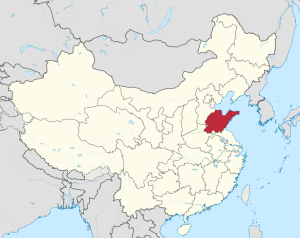From Classical Martial Arts Research Academy by Pertti Ruha
Ikai is a person who is present in the background to many of our schools.
In prehistory, Iga ryu, Gyokko Ryu and Togakure Ryu mentions a person by the name “Ikai” as an original source of these schools. Identifying Ikai [異 匀], with the alternative pronunciation “Ibou” ‘may be interpreted as “a charismatic person” (I; 異) from “foreign” (kai; 匀). The name can also be interpreted as “different person”, that is perhaps a “transgender”? A man dressed as a woman, or vice versa?
The sign [異] symbolizes “a person with demon head”. The Chinese pronunciation of these characters is “Yi Hui” or “Yi Gai”, but with the same meaning. A hypothetical conclusion to be drawn is that Ikai was a stranger and unusual even in China, perhaps initially of a people from eastern China.
In Hatsumi Sensei book Sengoku Ninpo Zukan (p.81) printed on 1978, Ikai was described as follows:
“During Huang You’s first year (possibly 1049), Ikai from Sijiang went into exile to the distant Japan, after losing the war against Ren Zong’s army, on the Qidan and Xia’s side. He came to Ise and settled in a cave in Iga.”
Sijiang is probably the same region as Shandong [山东] in today’s China. Because of its location on the North China Plain, Shandong area came into contact early on with the Chinese civilization whose cradle is just West of the present province. Both the first historical coated dynasties Shang Dynasty and Zhou Dynasty, controlled the western and central Shandong. The Shandong Peninsula was, for a long time outside the Chinese of influence. There lived the ethnic groups as the Chinese gave the name Dong Yi to, and who was regarded as barbaric, that is to say, nomadic.
The above-mentioned Ren Zong was Emperor Song Renzong of the Song Dynasty, ruled between 1023-1063. His real name was Zhan Zhen and was an emperor in the Northern Song Dynasty.
Xia is also known as Hsia and the Qidan are also known as Khitan. They were both a people who were related to Tungus, which in turn was a people who lived in northeastern Siberia. They were a significant nomadic people who dominated parts of what is today Manchuria and Inner Mongolia. The Russian word for China, Kitaj, is believed to originate from Khitan, as well as the older China name in English – Cathay.
If now Ikai had been a Chinese who fought on the Khitan and Hsia/Xia side against the Song Dynasty, then one can understand that he had to flee the Chinese continent in defeat, but it was more likely that he was a Khitan.
Oral tradition says that Ikai had been a general, and was very skilled in hicho ongyo no jutsu (飛鳥隠形之術). It was said that strangers, such as Ikai, Yi Gyokko (Yao Yu Hu) and Cho Busho (Zhang Wu Sheng) spread the knowledge of hichojutsu (飛鳥術), tode Koppojutsu (唐手骨法術), senban nage jutsu (旋盤投術) and the like to Japan. From this was born later Gyokko ryu kosshijutsu, Koto ryu koppojutsu, Gyokushin ryu kosshijutsu and Gikan ryu koppojutsu and others.
Considering that all the Koga ryu ninjutsu’s 53 traditions, and Iga ryu ninjutsu’s 30 traditions developed happo bikenjutsu based on Gyokko ryu’s teachings, the latter can be considered the oldest source of Japanese martial art.

In a text by Takamatsu, it says that Ikai had two students during the Johou period (1074-1077), namely Gamon Doshi and Hogenbo Tesshin. Ninjutsu was thus founded during the period between 1049 and 1077.
An alternative background for Ikai is that he was actually the same person as Hogenbo Tesshin. The reason is found in the book Essence of Ninjutsu, on pages 121-122. There, Takamatsu tells a story about an old man who talks to two students. The old man tells of the war when he fought on Kittan Ka’s (i.e., Khitan and Xia) side against King Jinso. Jinso is the Japanese pronunciation of the Chinese character for Renzong.
The story of the old man is consistent with the story of Ikai in Hatsumi sensei’s book Sengoku Ninpo Zukan (available in Japanese only). In Essence of ninjutsu, on page 122, it is mentioned that the old man is Hogenbo and the students are referred to as Ryutaro and Dosan.
According to the book, Ryutaro later became the great ninjutsu champion “Garyu Doshi” and Dosan survived further under the name Tendo Sakagami. This Tendo Sakagami can be the same person as Sakabe Tendo (mentioned in the prehistory of Togakure ryu and Shinden Fudo ryu Dakentaijutsu).

According to oral tradition, when he came to Japan, Ikai was presented to the Otomo clan who offered him a sanctuary in the distant Iga region.
Otomo, which means “great escort”, was a military clan who was considered to be descendants of Amaterasus grandson who pacified Japan. The power of the Otomo clan extended from the early Yamato period (250–710) to the Sengoku period, thus stretching over 1100 years.
Between the Yamato and the Heian period, Otomo had high military records in the Imperial Court, such as the life guards captain of the Empress Suiko.
The most famous ninja family – Hattori – were members of this clan. According to a legend, the life guards consisted of warriors of the Hayato people and it is therefore possible that the Hattori family came from this indigenous people.
According to the same legend, Ikai (sometimes also referred to as Chan Basho in Koto ryu documentation) trained parts of the Otomo clan in a unique form of combat technique – i.e. It is known today as ninjutsu, kosshijutsu and koppjutsu.
Translated by Luke Crocker from HERE.…
Read More
